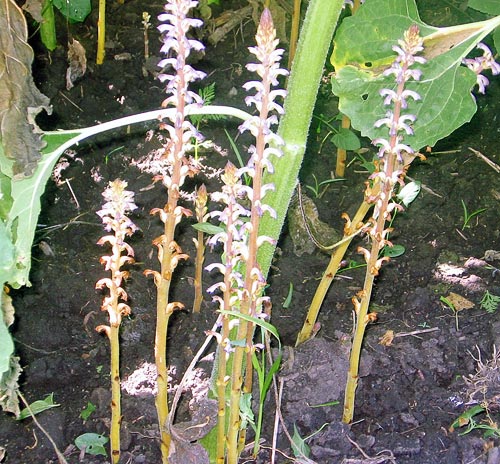Weeds
Orobanche cumana Wallr. - Sunflower Broomrape.
Systematic position.
Family Orobanchaceae, genus Orobanche.Biological group.
Parasitic weed.Morphology and biology.
Sunflower Broomrape is a parasitic weed, completely devoid of chlorophyll, affecting sunflower plant roots. After occurrence on soil surface, the parasite has whitish stalk, later becoming violet, with bluish tubular flowers with a bent crown. Stalk is simple, branchless, 50 cm in height. Further it turns brown, forming fruits as double-fold bolls. About 40 bolls are formed on a stalk, each containing up to 2,000 seeds. The seeds remain viable in the soil up to 12 years. The Broomrape seeds intensively sprout under the influence of root secretions of sunflower, also some insusceptible plant species. The Broomrape sprouts penetrate into root vasa of the host-plant, developing further at its expense, strongly oppressing sunflower growth. The severity of crop sowing colonization by Broomrape changes by regions and years. For example, in 1981, 230 flowers of the parasite were registered on one plant in Komrat district of Moldova in some sunflower fields. Sunflower Broomrape is a highly specialized parasite of sunflower, though it can sometimes affect some representatives of the family Asteraceae. The parasite populations on sunflower have a number of physiological races.Distribution.
Broomrape meets in all places of the world including Russia and other countries of the former USSR where sunflower is grown.Ecology.
The soil is the main source of the broomrape. Optimum conditions for seed germination in soil are temperatures 6-25°C and humidity 70% to 80%. Seeds of the parasite do not sprout at redundant soil humidity and temperatures less than 10°C or more than 35°C.Economic significance.
Broomrape is an extremely harmful object on sunflower. At earlier stages of sunflower selection in the USSR, crop losses reached 100%. Now they can make 50% and even more in steppe dry conditions on susceptible cultivars. Control measures include the use of resistant cultivars with obligatory crop rotation.Reference citations:
Fernadez-Martinez J., Melero-Vara J., Munoz-Ruz J., Domingues J. 2000.Selection of wild and cultivated sunflower by resistance to a new broomrape race that overcomes resistance of the Or5 gene. Crop Sci., p.550-555.Kukin V.F. 1982. Diseases of sunflower and measures of control against them. Moscow: Kolos, p.5-8 (in Russian).
Pustovoit V.S. 1975. Principal direction of selection work. Sunflower selection by resistance to broomrape and moth. In: Pustovoit V.S., ed. Sunflower. Moscow: Kolos, p.153-164 (in Russian).
Pustovoit V.S. 1990. Selected proceedings. The main sunflower diseases and pests. Moscow, Agropromizdat, p. 50-51 (in Russian).
Tolmachev V.V. 1996. Genetic control of sunflower resistance to broomrape (Orobanche cumana Wallr.). Eucarpia. Section of oil and protein crops. Proceedings of the symposium on breeding of oil and protein crops (5-8 august, 1996, Zaporozhye, Ukraine). Zaporozhye: Institute of Oilseed Crop of the Ukrainian Acad. of Agric. Sci. p.320-325.
Yakutkin V.I. 2001. Sunflower diseases in Russia and their control. Zaschita i karantin rastenii 10: 26-29 (in Russian).
Yakutkin V.I. 2005. Division of sunflower diseases in Russia and CIS countries. In: Pavlyushin V.A., chief ed. Second All-Russian Congress of Plant Protection. Saint Petersburg, 5-10 December, 2005. Phytosanitary improvement of ecosystems (Materials of Congress in two volumes). V. 1. Saint Petersburg: VIZR, p.125-127 (in Russian).


